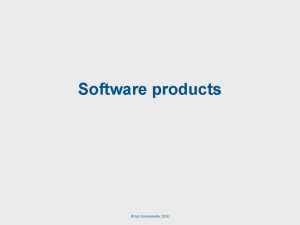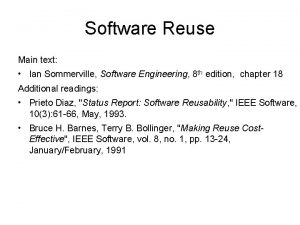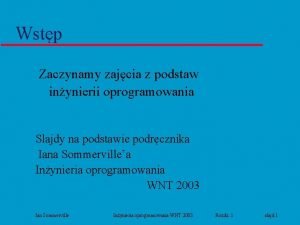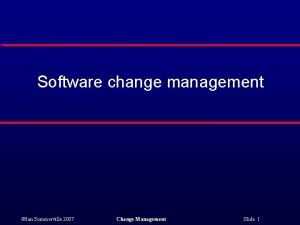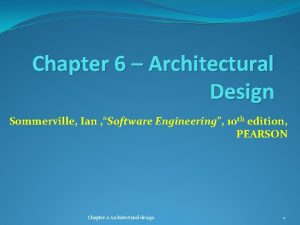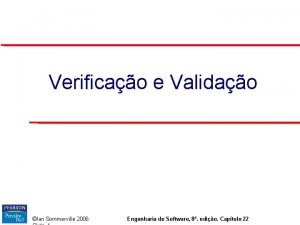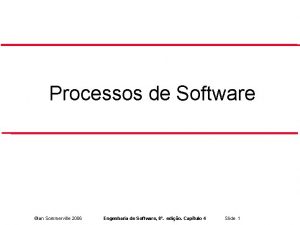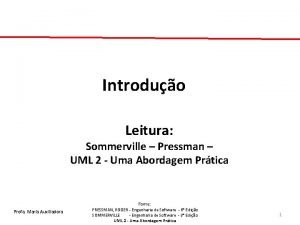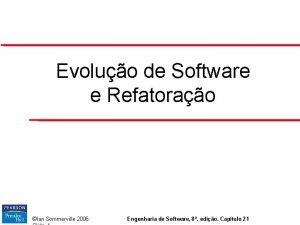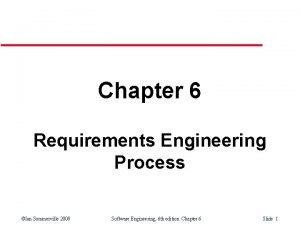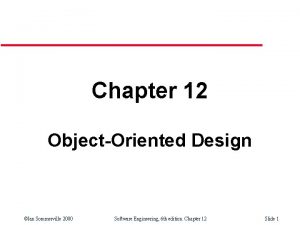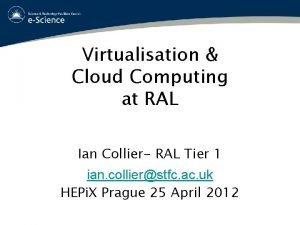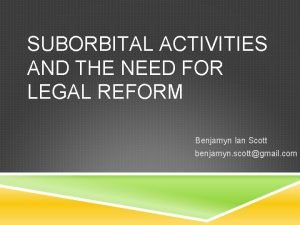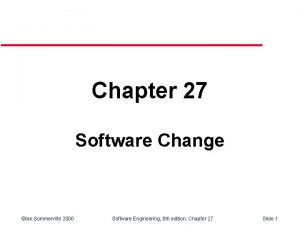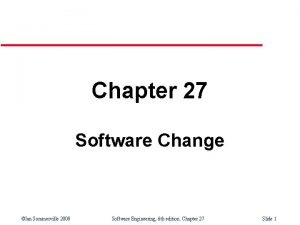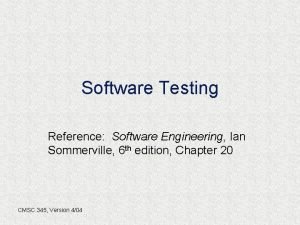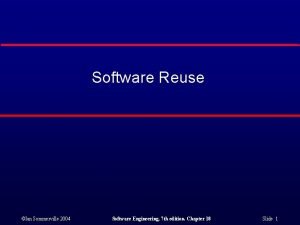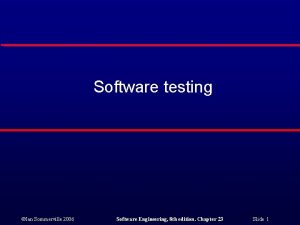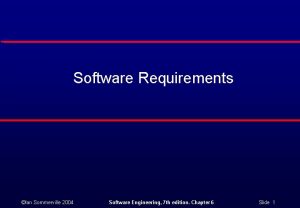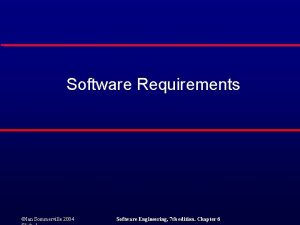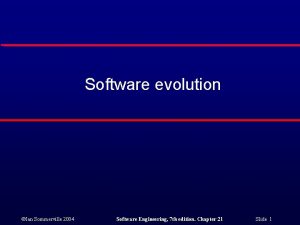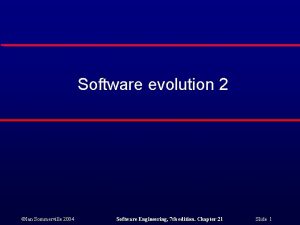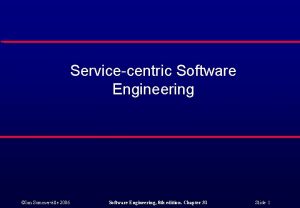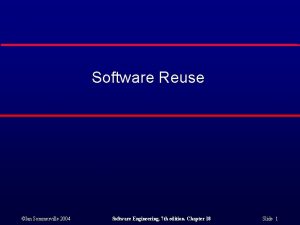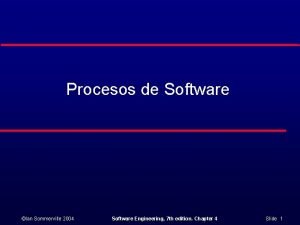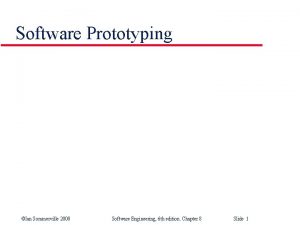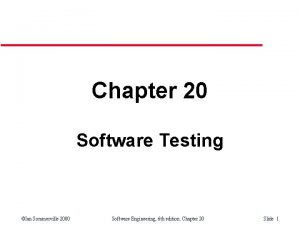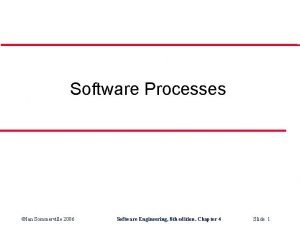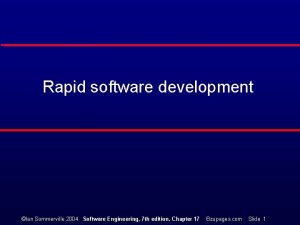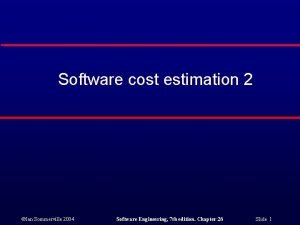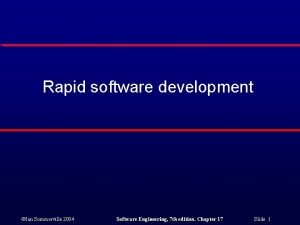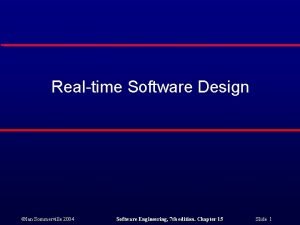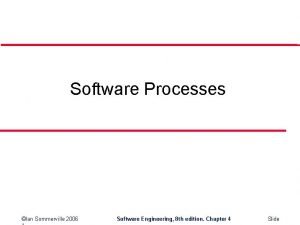Software change management Ian Sommerville 2007 Change Management
























- Slides: 24

Software change management ©Ian Sommerville 2007 Change Management Slide 1

Objectives l l l To explain the importance of software change management To describe key change management activities - planning, change management, version management and system building To discuss the use of CASE tools to support change management processes ©Ian Sommerville 2007 Change Management Slide 2

Change management l Software systems are subject to continual change requests: • • • l From users; From developers; From market forces. Change management is concerned with keeping track of these changes and ensuring that they are implemented in the most costeffective way. ©Ian Sommerville 2007 Change Management Slide 3

Change management requirements l l Some means for users and developers to suggest required system changes A process to decide if changes should be included in a system Software to keep track of suggested changes and their status Software support for managing changing system configurations and building new systems ©Ian Sommerville 2007 Change Management Slide 4

Change request form l l l The definition of a change request form is part of the CM planning process. This form records the change proposed, requestor of change, the reason why change was suggested and the urgency of change(from requestor of the change). It also records change evaluation, impact analysis, change cost and recommendations (System maintenance staff). ©Ian Sommerville 2007 Change Management Slide 5

Change request form ©Ian Sommerville 2007 Change Management Slide 6

Change tracking tools l l l A major problem in change management is tracking change status. Change tracking tools keep track the status of each change request and automatically ensure that change requests are sent to the right people at the right time. Integrated with E-mail systems allowing electronic change request distribution. ©Ian Sommerville 2007 Change Management Slide 7

Change approval l Changes should be reviewed by an external group who decide whether or not they are cost-effective from a strategic and organizational viewpoint rather than a technical viewpoint. Should be independent of project responsible for system. The group is sometimes called a change control board. The CCB may include representatives from client and contractor staff. ©Ian Sommerville 2007 Change Management Slide 8

Derivation history l l l This is a record of changes applied to a document or code component. It should record, in outline, the change made, the rationale for the change, who made the change and when it was implemented. It may be included as a comment in code. If a standard prologue style is used for the derivation history, tools can process this automatically. ©Ian Sommerville 2007 Change Management Slide 9

Configuration management l New versions of software systems are created as they change: • • • l For different machines/OS; Offering different functionality; Tailored for particular user requirements. Configuration management is concerned with managing evolving software systems: • • System change is a team activity; CM aims to control the costs and effort involved in making changes to the software system and associated documentation. ©Ian Sommerville 2007 Change Management Slide 10

Configuration management l l l Involves the development and application of procedures and standards to manage an evolving software product. CM may be part of a more general quality management process. When released to CM, software systems are sometimes called baselines as they are a starting point for further development. ©Ian Sommerville 2007 Change Management Slide 11

The configuration management plan l l Defines the types of documents to be managed and a document naming scheme. Defines who takes responsibility for the CM procedures and creation of baselines. Defines policies for change control and version management. Defines the CM records which must be maintained. ©Ian Sommerville 2007 Change Management Slide 12

The configuration management plan l l Describes the tools which should be used to assist the CM process and any limitations on their use. Defines the process of tool use. Defines the CM database used to record configuration information. May include information such as the CM of external software, process auditing, etc. ©Ian Sommerville 2007 Change Management Slide 13

Release management l l l Releases must incorporate changes forced on the system by errors discovered by users and by hardware changes. They must also incorporate new system functionality. Release planning is concerned with when to issue a system version as a release. ©Ian Sommerville 2007 Change Management Slide 14

System releases l l Not just a set of executable programs. May also include: • • • l Configuration files defining how the release is configured for a particular installation; Data files needed for system operation; An installation program or shell script to install the system on target hardware; Electronic and paper documentation; Packaging and associated publicity. Systems are now normally released on optical disks (CD or DVD) or as downloadable installation files from the web. ©Ian Sommerville 2007 Change Management Slide 15

System building l l The process of compiling and linking software components into an executable system. Different systems are built from different combinations of components. This process is now always supported by automated tools that are driven by ‘build scripts’. These may be separate tools (e. g. make) or part of the programming language environment (as in Java). ©Ian Sommerville 2007 Change Management Slide 16

System building problems l Do the build instructions include all required components? • l Is the appropriate component version specified? • l When there are many hundreds of components making up a system, it is easy to miss one out. This should normally be detected by the linker. A more significant problem. A system built with the wrong version may work initially but fail after delivery. Are all data files available? • The build should not rely on 'standard' data files. Standards vary from place to place. ©Ian Sommerville 2007 Change Management Slide 17

System building problems l Are data file references within components correct? • l Is the system being built for the right platform • l Embedding absolute names in code almost always causes problems as naming conventions differ from place to place. Sometimes you must build for a specific OS version or hardware configuration. Is the right version of the compiler and other software tools specified? • Different compiler versions may actually generate different code and the compiled component will exhibit different behaviour. ©Ian Sommerville 2007 Change Management Slide 18

Change management tools l l CM processes are standardised and involve applying pre-defined procedures. Large amounts of data must be managed. Tool support for CM is therefore essential. Mature CASE tools to support configuration management are available ranging from stand-alone tools to integrated CM workbenches. ©Ian Sommerville 2007 Change Management Slide 19

The configuration database l l All CM information should be maintained in a configuration database. This should allow queries about configurations to be answered: • • l Who has a particular system version? What platform is required for a particular version? What versions are affected by a change to component X? How many reported faults in version T? The CM database should preferably be linked to the software being managed. ©Ian Sommerville 2007 Change Management Slide 20

Change control tools l l Change control is a procedural process so it can be modelled and integrated with a version management system. Change control tools • • Form editor to support processing the change request forms; Workflow system to define who does what and to automate information transfer; Change database that manages change proposals and is linked to a VM system; Change reporting system that generates management reports on the status of change requests. ©Ian Sommerville 2007 Change Management Slide 21

Version management tools l Version and release identification • l Storage management. • l Record reasons for version creation. Independent development • l System stores the differences between versions rather than all the version code. Change history recording • l Systems assign identifiers automatically when a new version is submitted to the system. Only one version at a time may be checked out for change. Parallel working on different versions. Project support • Can manage groups of files associated with a project rather than just single files. ©Ian Sommerville 2007 Change Management Slide 22

System building l l l Building a large system is computationally expensive and may take several hours. Hundreds of files may be involved. System building tools may provide • • A dependency specification language and interpreter; Tool selection and instantiation support; Distributed compilation; Derived object management. ©Ian Sommerville 2007 Change Management Slide 23

Key points l l Change management is concerned with all of the activities around proposing, evaluating and implementing changes to a software system. Change control involves assessing the technical and economic viability of change proposals. Configuration management is the process of managing the evolving software product. Change management tools may be stand-alone tools or may be integrated systems which integrate support for change control, version management, system building and change management. ©Ian Sommerville 2007 Change Management Slide 24
 Engineering software products ian sommerville
Engineering software products ian sommerville Ian sommerville software engineering
Ian sommerville software engineering Inżynieria oprogramowania ian sommerville
Inżynieria oprogramowania ian sommerville Sommerville 2007
Sommerville 2007 Sommerville software engineering slides
Sommerville software engineering slides Sommerville
Sommerville Sommerville
Sommerville Sommerville
Sommerville Uml 2 uma abordagem prática
Uml 2 uma abordagem prática Sommerville
Sommerville Sommerville
Sommerville Sommerville
Sommerville Elaine sommerville
Elaine sommerville 666 rule powerpoint
666 rule powerpoint Diagnosis
Diagnosis Improving software economics
Improving software economics Ian milborrow pwc
Ian milborrow pwc Ian juliano
Ian juliano Ian ral
Ian ral Calptotectin
Calptotectin Ian scott international
Ian scott international Ian lipio
Ian lipio Ian coddington
Ian coddington Contractive autoencoder
Contractive autoencoder Ian crotty
Ian crotty
